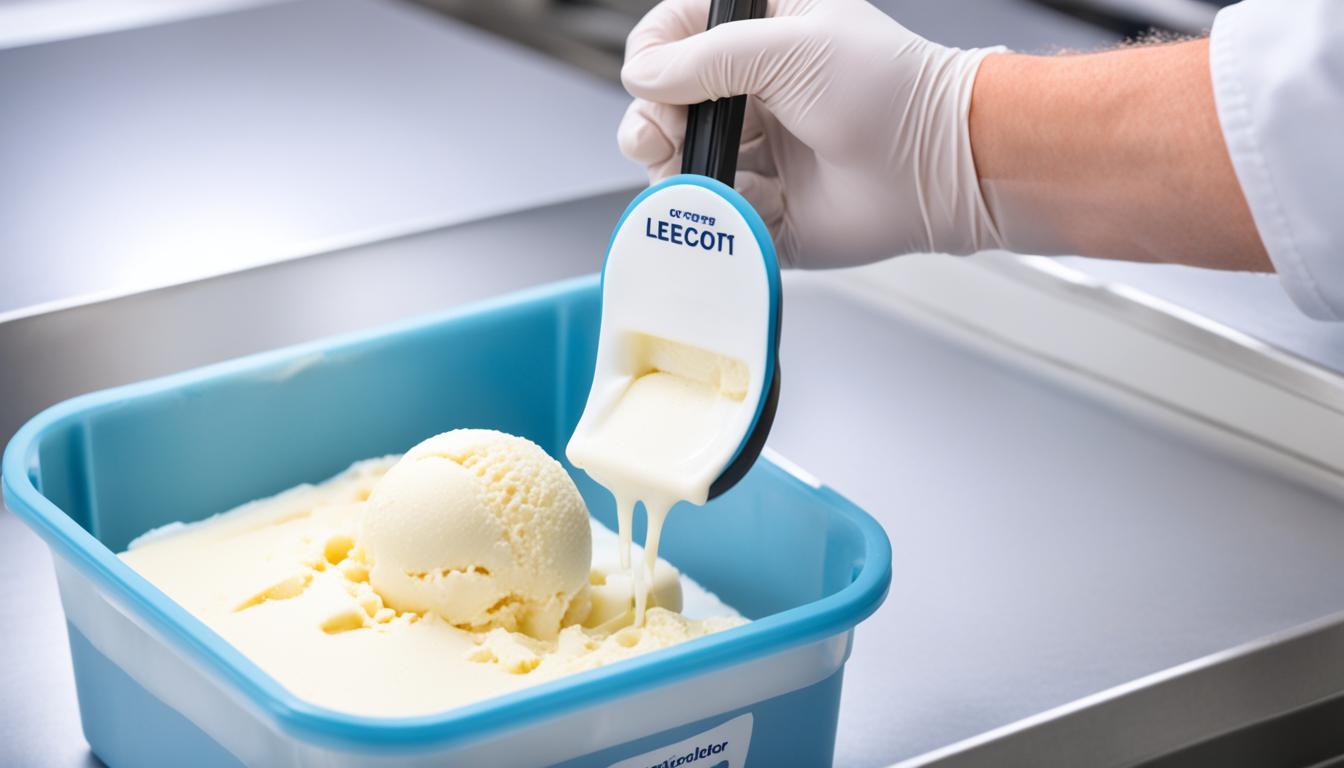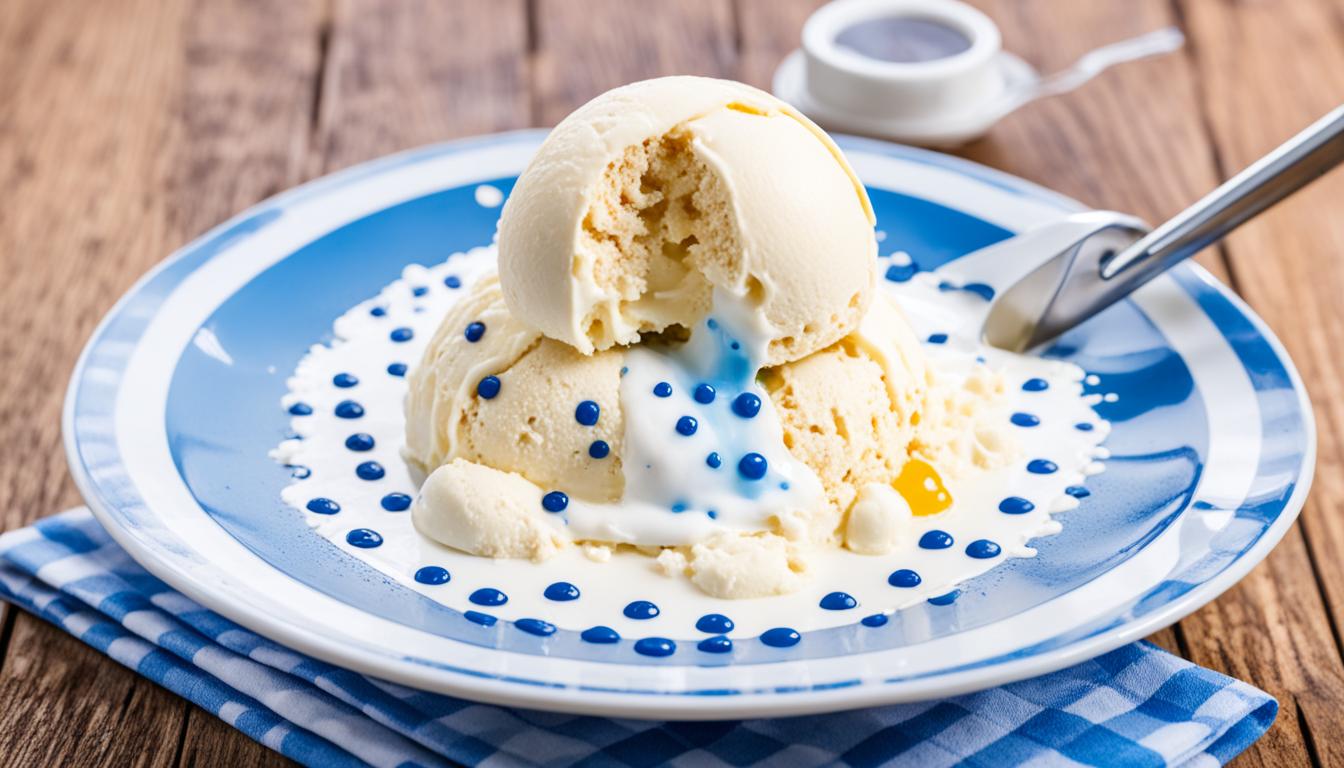Ice cream is often seen as a symbol of carefree indulgence, a comforting reminder of sunny days and joyful moments. But have you ever paused to consider the safety of this beloved treat? As tempting as it is to scoop into a pint of your favorite flavor, you might be wondering: can you get food poisoning from ice cream? Understandably, we all want our happy moments to remain unmarred by the unpleasant experiences of foodborne illness. It’s essential to recognize that while ice cream can bring immense joy, it also poses certain risks that can be easily overlooked. Being informed about ice cream safety can empower you to prevent food poisoning, ensuring that your sweet indulgences are nothing but delightful.
Key Takeaways
- Homemade ice cream made with eggs is a common source of Salmonella outbreaks.
- Using pasteurized egg products can significantly enhance ice cream safety.
- Keeping ice cream storage temperatures below 41°F is crucial to prevent bacteria growth.
- Practice safe serving techniques, such as using clean utensils and avoiding double-dipping.
- Be aware of symptoms of foodborne illness from ice cream, like fever and diarrhea.
- Discard any completely melted or thawed ice cream to prevent potential risks.
Understanding Food Poisoning
Questions about food safety often arise when discussing what is food poisoning. This serious health concern results from eating contaminated foods or beverages. Various pathogens, such as bacteria, viruses, and parasites, can lead to a foodborne illness. Common manifestations of food poisoning include nausea, vomiting, diarrhea, and abdominal cramping. You can reduce your risk by understanding the causes and maintaining vigilance about food safety.
What is Food Poisoning?
Food poisoning occurs when consuming food or liquids contaminated with harmful microorganisms. These pathogens thrive in improper storage conditions or unsafe food handling practices, making it crucial to ensure food safety throughout the cooking and eating process. Symptoms typically appear within hours of consumption, though delays may occur, depending on the type of pathogen involved.
How Common is Food Poisoning?
Food poisoning remains alarmingly prevalent. According to the Centers for Disease Control and Prevention (CDC), food poisoning statistics indicate around 48 million Americans, or approximately 15% of the population, get sick from foodborne diseases annually. Vulnerable groups, such as individuals aged 65 and older and pregnant women, face a higher risk of severe symptoms and complications. Awareness of such statistics can empower you to prioritize food safety during meal preparation and consumption.

| Pathogen | Incubation Period | Common Sources |
|---|---|---|
| Bacillus cereus | 30 mins – 15 hours | Rice, leftovers, sauces |
| Campylobacter | 2 – 5 days | Raw poultry, unpasteurized milk |
| Clostridium botulinum | 18 hrs – 30 days | Honey, canned foods |
| Escherichia coli (E. coli) | 3 – 4 days | Raw meat, unpasteurized juice |
| Giardia lamblia | 1 – 2 weeks | Contaminated food/water |
| Hepatitis A | 15 – 50 days | Raw shellfish, contaminated water |
| Listeria | 9 hrs – 4 weeks | Unpasteurized milk, deli meats |
| Norovirus | 12 – 48 hours | Shellfish, salads |
| Salmonella | 6 hrs – 6 days | Poultry, eggs, dairy |
| Staphylococcus aureus | 30 mins – 8 hours | Egg and potato salads |
| Vibrio | 2 – 48 hours | Raw fish, contaminated water |
How Ice Cream Can Cause Food Poisoning
The way ice cream is manufactured and handled plays a significant role in its safety. Understanding ice cream production safety is essential to prevent foodborne illnesses. The risks start with the manufacturing process, where contamination can occur if any ingredients are tainted. Even though many commercial ice creams use pasteurized milk and cream, unpasteurized eggs may still be used in some recipes, raising potential concerns. Monitoring food safety guidelines during production becomes crucial for avoiding any hazards.
The Manufacturing Process
Whenever ice cream is produced, it is vital to adhere to rigorous food safety guidelines. Contamination can happen at various stages, from sourcing ingredients to the final packing. Homemade ice cream presents its own set of challenges, especially when using raw eggs. It is best to choose recipes that utilize pasteurized eggs or powdered alternatives to mitigate the risks associated with foodborne pathogens.
The Risks of Melting Ice Cream
The risks of melting ice cream cannot be underestimated. When ice cream melts, it creates a perfect environment for bacteria such as Listeria to thrive. If this melted ice cream is later refrozen, the bacteria can survive, posing serious health risks. Once ice cream is left at room temperature, it falls within the danger zone of 40 to 140 degrees Fahrenheit, allowing harmful bacteria to multiply. If your ice cream is no longer frozen to the touch, it’s safer to discard it rather than attempt to refreeze it. Taking precautions when handling ice cream is essential for food safety.

For your own health and safety, you should consider the potential for cross-contamination. Sharing from the same container and double dipping with unclean utensils can introduce bacteria, heightening the risk of food poisoning. Being mindful during both production and consumption ensures you enjoy your favorite treat without compromising your safety.
Can You Get Food Poisoning from Ice Cream?
Ice cream, a beloved treat for many, can be a source of foodborne illness if not handled properly. Understanding the risks associated with pathogenic bacteria in ice cream is essential for anyone who enjoys this creamy delight.
Examples of Pathogenic Bacteria
Several foodborne pathogens can contaminate ice cream, posing significant health risks. Some well-known examples include:
- Salmonella: Often linked to ice cream made with raw eggs.
- E. coli: Can originate from contaminated ingredients like milk or food during production.
- Listeria: Particularly dangerous for vulnerable populations, found in unpasteurized dairy products and ready-to-eat foods.
In the context of recent outbreaks in states like Pennsylvania and New York, these pathogenic bacteria have been confirmed in ice cream products from certain manufacturers, highlighting the importance of awareness.
High-Risk Groups for Illness
Certain demographics are more susceptible to serious foodborne illnesses. The Centers for Disease Control and Prevention (CDC) identifies high-risk groups for food poisoning, which include:
- Pregnant women
- Young children
- The elderly
- Individuals with weakened immune systems
For these vulnerable populations, the consequences of consuming contaminated ice cream can be severe. Health officials recommend that individuals in these high-risk groups take extra precautions with their food choices, especially concerning ice cream products. This is particularly important for pregnant women, older adults, and individuals with weakened immune systems, who are more susceptible to foodborne illnesses. They should remain vigilant when selecting ice cream brands, ensuring they are sourced from reputable manufacturers and adhere to safety standards. For those wondering *”is nick’s ice cream healthy,”* it is crucial to not only consider nutritional content but also the safety and hygiene practices behind the product to make informed choices.

Where to Find Bacteria in Ice Cream
Understanding where bacterial contamination can occur in ice cream can help you maintain safe food handling practices. The ingredients in ice cream play a significant role in potential contamination. Specific components, as well as the preparation process, can introduce risks that could lead to illness.
The Role of Ingredients
Many ingredients in ice cream are essential for flavor and texture, yet they can also introduce bacterial risks. Pasteurized milk and cream significantly lower the chances of contamination. In contrast, ingredients like raw eggs can be problematic due to the potential presence of Salmonella. To ensure safe ingredient use, always opt for pasteurized eggs in homemade ice cream recipes. Following this guideline is crucial for reducing ice cream preparation risks.
Potential Contamination During Preparation
Contamination during the preparation of ice cream can occur in several ways. Cross-contamination can happen if utensils or hands that have touched other foods come into contact with the ice cream mixture. This transfer of bacteria increases the risk of foodborne illness. Additionally, if ice cream melts and is not refrozen promptly, the warmer temperature creates an environment where bacteria can thrive. Practicing safe food handling during preparation is essential to prevent these risks and ensure delicious, safe-to-eat ice cream.

Ice Cream Storage Guidelines
Ensuring the safety of your ice cream begins with proper storage. Understanding how to store ice cream is key to preventing any risk of foodborne illness. Bacterial growth can occur if ice cream warms up, making it essential to keep it frozen at all times. Following these guidelines will help you maintain optimal ice cream storage and enjoy delicious treats safely.
Importance of Freezing
Freezing is essential for preserving the quality and safety of ice cream. Microorganisms thrive at higher temperatures, capable of doubling in number every 20 minutes when conditions are right. When storing ice cream, aim for temperatures below -18°C (0°F) for regular storage, while serving should occur at around -12°C (10°F). Adhering to these temperatures minimizes the risk of contamination and ensures that your ice cream remains delightful.
Best Practices for Storing Ice Cream
To maximize the safety and longevity of your ice cream, follow these food safety tips:
- Store ice cream in its original container to prevent cross-contamination.
- Avoid frequent opening of containers, as this introduces warm air that promotes melting.
- Label homemade ice cream with preparation dates to monitor freshness.
- Utilize clean utensils when serving to avoid transferring bacteria.
- Do not refreeze melted ice cream; once it’s been thawed, consume it or discard it.
- Maintain hygiene practices from ingredient intake all the way through to serving.
By following these ice cream safety tips, you can ensure that your frozen treats remain safe and enjoyable. Keeping vigilant in your storage practices allows you to savor delicious ice cream without concern.

Ice Cream Temperature Control
Maintaining the right temperature for ice cream is essential for ensuring its safety and quality. The recommended freezer temperature to keep ice cream safe is 0°F (-18°C) or below. This lower temperature helps inhibit bacterial growth, making it vital for ice cream safety.
Recommended Freezer Temperature
To effectively prevent foodborne illnesses, always store your ice cream at the recommended freezer temperature of 0°F or lower. Any rise in temperature can trigger the growth of harmful bacteria such as Salmonella or E. coli, especially if the ice cream isn’t handled hygienically. Monitor your freezer regularly to ensure it maintains this safe temperature, and check expiration dates on ice cream packaging for added precaution.
Signs of Temperature Abuse
Be vigilant for signs of ice cream temperature abuse. Common indicators include:
- Unusual texture changes – Ice cream that becomes overly soft or mushy is a clear warning.
- Icy crystals – Large ice crystals forming on the surface can signal previous melting and refreezing.
- Frost on containers – This can indicate exposure to air and temperature fluctuations.
If you notice any of these signs, consider discarding the ice cream to uphold food safety standards. Ensuring proper storage and being aware of these warning signs will help you avoid the risks associated with consuming poorly maintained ice cream.

Food Safety Tips for Handling Ice Cream
Ensuring proper food safety practices is vital when it comes to enjoying ice cream. By following safe serving techniques and adhering to professional food safety tips, you can significantly reduce the risk of foodborne illnesses. Here’s how to keep your ice cream experience safe and enjoyable.
Clean Utensils and Serving Techniques
Using clean utensils is critical when handling ice cream. Always wash your hands thoroughly with soap and water before serving. Avoid double-dipping or licking serving spoons, as these behaviors can introduce harmful bacteria into the ice cream container. Maintaining proper hygiene practices supports ice cream safety and helps prevent cross-contamination.
Cross-Contamination Prevention
To prevent cross-contamination, it’s essential to keep ice cream containers properly sealed when not in use. Make sure utensils used for serving do not touch surfaces that have been in contact with raw foods, such as raw meat or seafood. These small actions contribute greatly to food safety, ensuring your ice cream remains a delicious and safe treat.

Symptoms of Foodborne Illness from Ice Cream
Understanding the symptoms of foodborne illness can help you act quickly in case you experience food poisoning from ice cream. Different types of bacteria can lead to various signs of illness, which may appear within hours or days after consuming contaminated ice cream. By being aware of these symptoms, you can take the necessary steps to protect your health.
Common Symptoms to Watch For
When food poisoning occurs, symptoms can manifest in various forms. Some common signs to look out for include:
- Nausea and vomiting
- Abdominal cramps and pain
- Diarrhea
- Headaches
- Fever and chills
- Muscle aches
- Dehydration
Understanding these symptoms of foodborne illness can empower you to act swiftly if you suspect food poisoning.
When to Seek Medical Attention
It is important to recognize when to seek medical help for food poisoning. If symptoms persist, worsen, or if you are part of a high-risk group, you should consult a healthcare professional. Serious signs include:
- High fever
- Prolonged diarrhea
- Severe dehydration
Taking these symptoms seriously can ensure proper care and recovery. Do not hesitate to reach out for help if you experience any of these critical symptoms.

Preventing Food Poisoning When Eating Ice Cream
Enjoying ice cream can be a delightful experience, but it’s essential to prioritize food safety practices to prevent food poisoning. Certain precautions and safe eating practices can help you indulge in your frozen treats with peace of mind.
What to Avoid
To significantly reduce the risk of food poisoning, steer clear of ice cream made with unpasteurized eggs or milk. Such ingredients can harbor harmful bacteria, particularly Salmonella. Another major pitfall is consuming melted ice cream that has been refrozen. This not only compromises texture but also creates an ideal environment for bacteria like Listeria to flourish. Additionally, avoid double-dipping into shared containers to prevent cross-contamination.
Safe Practices at Home and Out
When enjoying ice cream, ensure it remains frozen until serving. Use clean utensils to serve the treat and never refreeze completely melted ice cream. If you are at an event or in a social setting, pay attention to how the ice cream is stored. It should not be left out for extended periods, as maintaining proper temperature is vital for food safety at home and out. Prioritize safe eating practices by opting for ice creams made with pasteurized ingredients whenever possible.

| Actions | What to Avoid |
|---|---|
| Use clean utensils | Avoid double-dipping |
| Keep ice cream frozen | Consuming melted ice cream that has been refrozen |
| Choose pasteurized ingredients | Avoid ice creams made with unpasteurized eggs or milk |
| Consume quickly if served at an event | Leaving ice cream out at room temperature |
Taking these steps not only protects your health but also ensures that your ice cream experiences remain joyful and carefree. By practicing food safety at home and out, you defend against foodborne illnesses while savoring your favorite flavors.
Alternatives to Traditional Ice Cream
For those seeking safer ice cream options, various alternatives exist that cater to both dietary preferences and safety concerns. Vegan ice cream has gained popularity for its health benefits and lower risk of bacteria contamination. Without animal products, these desserts provide a delicious indulgence minus the potential dangers associated with raw eggs and unpasteurized dairy.
Vegan and Dairy-Free Options
Dairy-free ice cream alternatives are a wonderful choice for those who are lactose intolerant or prefer plant-based diets. These products often incorporate ingredients such as almond milk, coconut milk, or soy milk, making them not only vegan-friendly but also less susceptible to harmful bacteria. When selecting vegan ice cream, look for options that use natural sweeteners and minimal additives to further enhance their health benefits.
Using Pasteurized Ingredients
Another approach to enjoying ice cream safely at home involves the use of pasteurized ice cream ingredients. By using pasteurized milk and eggs, you significantly reduce the risk of foodborne pathogens that can arise from raw components. Making homemade ice cream with pasteurized products ensures a creamy treat without the fear of contamination. Here, you can control the flavors and ingredients while maintaining food safety standards.

| Option | Ingredients | Benefits |
|---|---|---|
| Vegan Ice Cream | Almond milk, coconut milk, fruits | Dairy-free, lower risk of bacteria |
| Dairy-Free Alternatives | Cashew cream, oat milk, soy milk | Lactose-free, rich in flavors |
| Homemade Ice Cream | Pasteurized milk, pasteurized eggs, natural sweeteners | Controlled ingredients, fresher taste |
By opting for vegan ice cream products or using pasteurized ingredients, you can enjoy delicious desserts while prioritizing food safety alternatives. Making informed choices allows you to indulge in ice cream without compromise, supporting both your health and taste preferences.
Conclusion
Understanding the risks associated with ice cream is essential for enjoying this beloved treat without worry. This ice cream safety recap highlights the importance of adhering to food safety guidelines, such as proper storage at temperatures below -18°C (0°F) to prevent bacterial growth. Additionally, being aware of cross-contamination risks and maintaining good hygiene practices are critical steps in food poisoning prevention.
Taking the time to check expiration dates and recognizing signs of contamination will ensure that you make informed choices about the ice cream you consume. Remember, symptoms of foodborne illness from ice cream can range from nausea to abdominal pain and fever, making it vital to prioritize your health.
Ultimately, by following best practices and staying alert to food safety tips, you can savor your favorite scoop without fear. Embracing these precautions ensures that ice cream remains a delightful dessert in your life, enjoyed with peace of mind.









